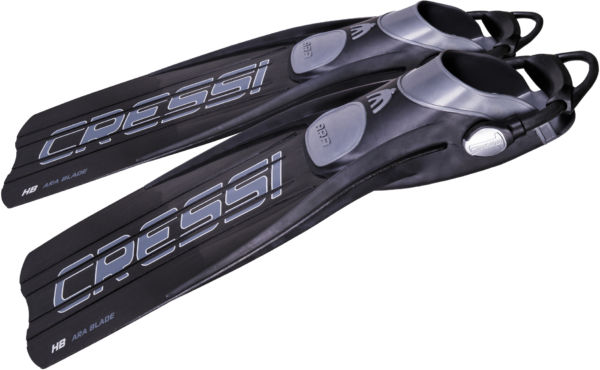Jet fins, split fins, paddle fins, and even flippable fins: you’re spoiled for choice when you decide to buy your first pair of scuba diving fins. So, what are these different types, exactly, and who are they for? We’re here to take some of the mystery out of fin shopping and help you get the right pair so you have a pair of fins that suits your fin kick of choice. Let’s get started with your first key decision: open heel or full-foot fins?
Open-heel vs. full-foot fins

Open-heel scuba fins feature a firm foot pocket that is open at the rear. A strap that reaches from either side of the fin and around the back of your heel keeps the fins in place on your feet. Divers who use open-heel fins always wear diving boots, which either attach directly to their drysuits, or are separate neoprene booties dedicated to scuba diving. As you can imagine, wearing boots with a thick sole allows divers to walk comfortably over sand, rocks, or other surfaces.

On the other hand, divers who use full-foot fins have nothing on their feet but the fins themselves. These scuba diving fins feature a thinner, more flexible foot pocket than open-heel fins. The pocket extends all the way around the back of the diver’s heel, keeping the fins firmly in place.
Those who dive exclusively off boats in warm water typically favor full-foot scuba fins. Because these divers don’t have to make shore entries, they don’t need the protection a boot offers. And, in warmer waters, the warmth that separate boots offer isn’t typically necessary.
That said, as a general rule of thumb, open-heel fins have a wider range of use and are better suited to certain dive environments. Ultimately, you should buy the fins that suit where you’d like to dive. If you’re only ever going to dive off a boat, full-foot fins are fast, easy and convenient. Plus, you won’t have to buy boots. But if you’re making an investment and you want fins that you can take anywhere, open-heel plus booties is best.
Now that we’ve got the basics out of the way, let’s look at the types of fins you’ll see for sale.
Basic Types of Scuba Diving Fins
While each type has its merits — with the possible exception of flippable fins (more on those later) —certain scuba fins may be better suited to certain types of diving. Plenty of divers will tell you exactly why the fins they use are best but at the end of the day, much of it just comes down to personal preference.
Paddle Fins
Interestingly, no one in the dive industry ever calls these “paddle” fins, because they’re the original fin. Featuring a solid yet flexible blade, paddle fins can be either open-heel or full foot. Design features such as channels and small cutouts in the blade aid propulsion underwater.
Jet Fins
Once the preserve of technical divers, heavy jet fins are growing in popularity and plenty of recreational-only divers prefer them. You can tell jet fins by their seemingly clunky design, vented slots near the foot pocket, and by the fact that most are exclusively black.
After you learn to use them correctly, jet fins offer a lot of power with minimal effort. But, if you’re buying your first-ever pair of scuba diving fins, try paddle fins first. Jet fins are substantially more expensive and harder to use initially. Jet fins are always open-heel.
Split Fins
The idea behind split fins it that they offer more speed and power with less effort. Here, the fin’s blade is split into two parts to reduce drag. A raging debate endures in the scuba world between split-fin proponents and those who think split fins are pointless. This is really a matter of preference. Split fins are easy to use with no special knowledge or fin stroke required.
Hinged Fins
Hinged fins are like a standard paddle fin but the fin’s blade is connected to a hinge mechanism that allows the blade to flip upward and away from the foot pocket. The idea here is that divers can walk comfortably in their scuba diving fins. It seems like a good idea, however, that hinge point represents a significant vulnerability. Having your fin flip or break underwater is less than ideal. We recommend that you give these a pass and put your fins on in the water or on the boat.
Fitting Your Scuba Fins
Open-Heel
Open-heel fins come in sizes from XXS to XXL. Expect to see sizes such as SM (small-medium) and ML (medium-large). To check the fin fits well, place your foot (with the scuba boot on) inside the foot pocket. Your foot should feel snug and secure but not too tight. There should be two to three fingers’ width between the base of the foot pocket and the heel of your boot. Do not walk around the shop in the fins.
Full-Foot
Full-foot fins come in traditional size categories and often in ranges, for example, size 39 to 41. To check if a full-foot fin fits well, roll the back of the foot pocket down and slot your foot in. Then roll the rubber pocket back up and over your heel. Your foot should be quite snug but not constricted in any way.
As above, don’t walk around in your fins, there really are better ways of testing them. If you’re buying online, make sure you check the manufacturer’s sizing guidelines.
We hope our brief guide to buying your first scuba fins has helped with some of the questions you had. If you would like to know anything else about scuba diving fins, please drop us a comment below and we’ll get back to you soon!

